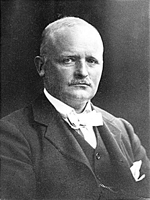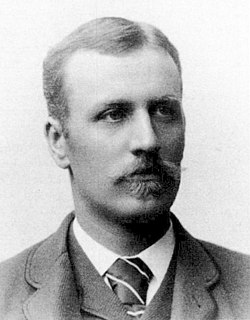

Ernst Carl Westman (February 20, 1866 - January 23, 1936) was a Swedish architect and interior designer. He was an early adopter of the National Romantic Style, but turned later to the neo-classical style of the 1920s.


Ernst Carl Westman (February 20, 1866 - January 23, 1936) was a Swedish architect and interior designer. He was an early adopter of the National Romantic Style, but turned later to the neo-classical style of the 1920s.
Carl Westman was born in Uppsala in 1866. He studied at the Royal Institute of Technology in 1885-1889, and then at the Royal Swedish Academy of Arts in 1889-1892, in Stockholm. In 1893 he married artist Elin Andersson and moved to the United States where he practiced with architect R. L. Daus in New York City in 1893-1895.
In 1895, he returned to Stockholm to work for architect Aron Johansson (who at that time was the architect working with the new Parliament building (1895-1904) in Stockholm). In 1897, Westman opened his own architect bureau. He became a member of the Royal Swedish Academy of Arts in 1912 and in 1916 he became the chief architect of the Swedish Royal Medical Board.
Carl Westman was one of the foremost advocators in Sweden for a return to the national characteristics in architecture. He was one of the first Swedish architects who developed the new Nordic National Romantic Style, a style which took the cultural and building precedents and merged them with ideas from the English Arts and Crafts movement to create a very distinct Swedish architecture often in brick and wood.
Carl Westman's Swedish General Medical Association building in Stockholm (1904-1906) was the first building built in the National Romantic Style, with the Röhss Museum in Gothenburg (1910-1914) and Stockholm Court House (1911-1915), providing another two prominent examples. The Stockholm Courthouse has striking similarities with the medieval Vadstena Castle, and provides a dazzling sight in downtown Stockholm, though the building proves quite inflexible for its purposes.
Later on, Westman worked particularly as a hospital architect, gradually adopting the classical style of the 1920s, with noted examples being the Beckomberga Hospital (1927-1935), and the Karolinska Hospital (1935-1940) which was completed after his death. Whereas the psychiatric hospital at Beckomberga was strictly symmetrically planned, with massive buildings grouped in a fairly functional pattern, the Karolinska hospital strives towards a more functional architecture where the symmetrical design was toned down.
Carl Westman was also a part-time interior designer of furniture and utility supplies such as tiled stoves. He died in Stockholm in 1936.

Art Nouveau is an international style of art, architecture, and applied art, especially the decorative arts, known in different languages by different names: Jugendstil in German, Stile Liberty in Italian, Modernisme català in Catalan, etc. In English it is also known as the Modern Style. The style was most popular between 1890 and 1910 during the Belle Époque period that ended with the start of World War I in 1914. It was a reaction against the academic art, eclecticism and historicism of 19th century architecture and decoration. It was often inspired by natural forms such as the sinuous curves of plants and flowers. Other characteristics of Art Nouveau were a sense of dynamism and movement, often given by asymmetry or whiplash lines, and the use of modern materials, particularly iron, glass, ceramics and later concrete, to create unusual forms and larger open spaces.

Victor Pierre Horta was a Belgian architect and designer, and one of the founders of the Art Nouveau movement. His Hôtel Tassel in Brussels built in 1892–1893, is often considered the first Art Nouveau house, and, along with three of his other early houses, is listed as a UNESCO World Heritage Site. The curving stylized vegetal forms that Horta used influenced many others, including architect Hector Guimard, who used it in the first house he designed in Paris and in the entrances he designed for the Paris Metro. He is also considered a precursor of modern architecture for his open floor plans and his innovative use of iron, steel and glass.
Westman may refer to:

Charles Francis Annesley Voysey was an English architect and furniture and textile designer. Voysey's early work was as a designer of wallpapers, fabrics and furnishings in a Arts and Crafts style and he made important contribution to the Modern Style, and was recognized by the seminal The Studio magazine. He is renowned as the architect of several country houses.

The Baroque Revival, also known as Neo-Baroque, was an architectural style of the late 19th century. The term is used to describe architecture and architectural sculptures which display important aspects of Baroque style, but are not of the original Baroque period. Elements of the Baroque architectural tradition were an essential part of the curriculum of the École des Beaux-Arts in Paris, the pre-eminent school of architecture in the second half of the 19th century, and are integral to the Beaux-Arts architecture it engendered both in France and abroad. An ebullient sense of European imperialism encouraged an official architecture to reflect it in Britain and France, and in Germany and Italy the Baroque Revival expressed pride in the new power of the unified state.

Hack Kampmann was a Danish architect, Royal Inspector of Listed State Buildings in Jutland and professor at the architecture department of the Royal Danish Academy of Fine Arts. Marselisborg Palace in Aarhus, built between 1899 and 1902, is among his best known works.

Carl Nyrén was a Swedish architect.
This article covers the architecture of Sweden from a historical perspective.

Erik William Bryggman was a Finnish architect. He was born in Turku, the youngest of the five sons of Johan Ulrik Bryggman (1838–1911) and Wendla Gustava Bryggman (1852–1903). He began studies in architecture at Helsinki University of Technology in 1910 and qualifying as an architect in 1916. In 1914 he and fellow student Hilding Ekelund made a study trip to Denmark and Sweden. In 1920 he travelled to Italy, where he became inspired more by the local vernacular architecture than the classical or Baroque works. He worked in Helsinki for various architects, including Sigurd Frosterus, Armas Lindgren, Otto-Iivari Meurman and Valter Jung before starting his own office in Turku in 1923. Bryggman's architecture is noted for its combination of Nordic, classical and modernist characteristics.

Beckomberga Hospital was a Swedish psychiatric hospital, situated in Bromma west of Stockholm. Opened in 1932, Beckomberga was in its mid-20th century heyday one of the largest psychiatric hospitals in Europe, housing some 2,000 mentally ill patients. The hospital was closed in 1995.

Nordic Classicism was a style of architecture that briefly blossomed in the Nordic countries between 1910 and 1930.

Isak Gustaf Clason was a Swedish architect.

Waldemar Wilenius was a renowned Finnish architect at the end of the 19th century and beginning of the 20th century designing buildings in first a Neo-Renaissance style before moving to an Art Nouveau style. Wilenius completed his studies at the Finnish Polytechnical Institute in 1889, after which he undertook further studies at the Royal Swedish Academy of Arts in Stockholm and the Technical University of Berlin. After his studies he returned to Helsinki where he worked at the National Board of Building, fulfilling various positions until 1889. He also established his own architect's office. Wilenius is particularly known for a number of apartment blocks built in the centre of Helsinki.

Johan Fredrik Lilljekvist was a Swedish architect. He is best known for his controversial restoration of Gripsholm Castle and as the architect of the new building for the Royal Dramatic Theatre in Stockholm.

Carl Oskar Möller,, was a Swedish architect and public official, since 1896 married to Dagmar Bosse. His most well-known works include St. John's Church in Stockholm, which opened in 1890. Möller was in his time in architectural arrangement terms one of the foremost exponents among Swedish architects.

Haldor Larsen Børve was an architect from Ullensvang in Hordaland, Norway. Børve started an architectural practice in Porsgrunn in 1889 and designed numerous buildings in Telemark and Vestfold, many of them influenced by Dragestil and the Nordic National Romantic style. Among his best-known works are Dalen Hotel from 1894 and Porsgrunn City Hall from 1904/1905.

Carl Gustaf Bergsten was a Swedish architect. He graduated in 1901 from the KTH Royal Institute of Technology and three years later from the Royal Swedish Academy of Fine Arts in Stockholm. A scholarship took him to Germany and to Vienna. He apprenticed with architects Isak Gustaf Clason and Erik Lallerstedt. Bergsten ran his own architectural firm from 1904-35. He was influenced by the National Romantic style and Functionalism. He designed a number of exhibition spaces including Liljevalchs konsthall. For the Norrköping Exhibition of Art and Industry in 1906, Bergsten designed the exhibition's two main buildings the Industrial Hall (Industrihallen) and the Art Exhibition Hall (Konsthallen) as well as the Hunting Pavilion (Jaktpaviljongen).

Gustaf Nyström was a Finnish architect. Nyström has been described as one of the most important architects in Finland at the end of the 19th century and the beginning of the 20th century. He was active both as an influential teacher, as an architect in his own right, and as an official involved in groundbreaking urban planning projects.

Ernst Wilhelm Emanuel Stenhammar was a Swedish architect. He was active both as an independent architect and as a teacher and eventually professor of architecture in Stockholm. The main bulk of his designs as an independent architect were made for banks and hospitals.
| Wikimedia Commons has media related to Carl Westman . |